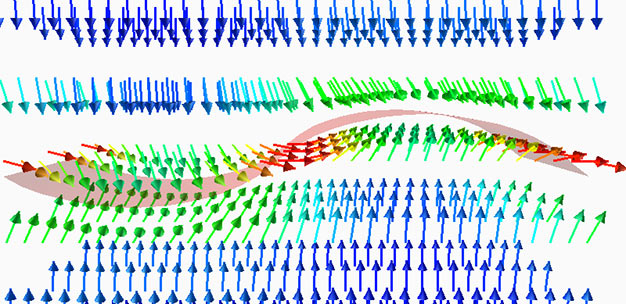Broken symmetries may provide a pathway to a unified theory of the Universe
Published online 6 March 2015

Domains are regions in magnets where the magnetism points in different directions (blue arrows). Separating these domains are domain walls, which can show dynamic wave motions of the magnetic direction (green, red arrows).
© 2015 Michikazu Kobayashi, Kyoto University, and Muneto Nitta, Keio University
Symmetry is an important mathematical concept that forms the basis of fundamental laws of the Universe. Researchers in Japan have now uncovered that imperfections rather than perfect symmetry might hold the key to understanding the forces that drive the Universe.
The fundamental forces of the Universe such as gravity, magnetism, and even space and time itself are inherently symmetric, which means that they exhibit the same properties in all directions. Therefore, physicists searching for a unified theory that can describe the Universe and all its forces are looking for theories that are based on perfect symmetries.
Their efforts, however, have run into a dead end. While it has been possible to unify most fundamental forces based on symmetry principles, adding gravity has been impossible. Muneto Nitta from Keio University and Michikazu Kobayashi from Kyoto University have now discovered that looking for perfect symmetries might be the wrong approach. "Our finding suggests a possibility of unification of gravity with other fundamental forces, if the relativistic symmetry is spontaneously broken," says Nitta.
Rather than studying forces and their symmetries at the high energies that were present in the cosmos right after the creation of the Universe, the researchers focused on low energies, such as conventional magnets. Magnets that are fully magnetized are symmetric, meaning that their magnetic components all point in the same direction. However, at intermediate magnetizations magnetic domains form, which are regions with different magnetic orientations. Separating these regions are domain walls, across which the magnetic orientation of atoms switches (see the arrows in the image).
Domain walls break the symmetry of magnets and this results in energetic excitations, like when a stone is thrown into a pond. The energy created by the stone breaking the perfect symmetry of the water's surface creates small ripples. Similarly, the magnetic fields across a domain wall can also create ripples (see video).
Applying a theoretical framework of equations describing broken symmetries, Kobayashi and Nitta showed that some of these ripples are the consequence of a coupling of the magnetic force and the space and time symmetry of the material1.
Given the difficulties in unifying symmetries of fundamental forces with space and time at high energies, this coupling was unexpected, and, says Nitta, "can provide some hints for unified high-energy theories." While the present findings apply only to low-energy dynamics, the strategy of unifying fundamental forces through broken rather than perfect symmetries could lead to an entirely new understanding of the Universe.
Domain walls break the symmetry in a magnet. The magnetic field across a domain wall (represented by arrows) moves like the ripples on the surface of an unsettled pond.
© 2015 Michikazu Kobayashi, Kyoto University, and Muneto Nitta, Keio University
Reference
- Kobayashi, M. & Nitta, M. Nonrelativistic Nambu-Goldstone modes associated with spontaneously broken space-time and internal symmetries. Physical Review Letters 113, 120403 (2014). | article